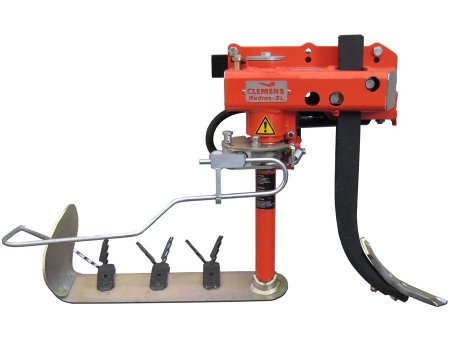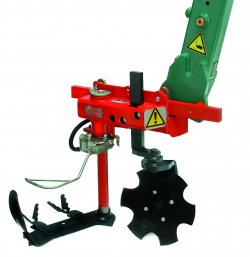In-row blade tool
Tools with an in-row blade cut a strip of soil horizontally without moving the soil, thus drying out the plants. The blade, 35 to 60 cm long, works at a depth of just a few centimetres and can be fitted with accessories to improve its effectiveness. The tool is generally retracted by a hydraulic cylinder or a hydraulic torque amplifier for precise, progressive control.
The tool's settings include position, safety distance via the feeler and forward speed, with devices to loosen compacted soil before the blade passes.
The tool's settings include position, safety distance via the feeler and forward speed, with devices to loosen compacted soil before the blade passes.

Work objective
Tools with inter-weeder blades can be used to cut a strip of soil horizontally to a depth of a few centimetres, without moving the soil. This action causes the aerial part of the plant to dry out. This type of cultivation is known as flat cultivation, as opposed to ploughing, which modifies the relief of the soil.Components of in-row blade tools
The blade
The blade is between 35 and 60 cm long and works at a depth of just a few centimetres on a horizontal plane. Manufacturers offer the option of adding accessories such as wings positioned vertically on the blade. It is also possible to add a small lug to the end of the blade, which gives the blade a slight scraping action around the foot.For use in compact soils, it is advisable to combine the blade with a rigid tine or a coulter to loosen the soil at the pivot point.

Combined in-row tool: blade and disc
The eradication system
there are 2 main removal systems for the rotary tool:- The hydraulic cylinder
- The hydraulic torque booster
Adjustment and use of hydraulic blades
There are three main ways of adjusting a blade tool:Position of the tool
It must be centred in the row and the width of the tool must be correctly adjusted (taking into account the crossing of the tool) in order to avoid unworked areas and injury to the vines.The position of the feeler
This determines the safety margin between the tool blade and the vine stock. The greater the distance between the blade and the sensor, the greater the safety margin. In addition, the sensor should be as close to the ground as possible to determine the position of the vine as accurately as possible.Forward speed
Forward speed. This is fairly fast (up to 6 hm/h), but must not be too fast to allow the blade to return between the stumps.At Actisol, there is no mechanical or hydraulic device to release the blade. Withdrawal is achieved by differential pressure on the two blades in contact with the stock. The additional pressure exerted by the stock on the blade causes it to pivot around a central pivot point. Between the vines, the blade aligns itself when the balance of pressure is found.
In all cases, there are problems with the blade penetrating the soil in compact terrain. To overcome this difficulty, the blade's pivot axis can be loosened up before passing through the soil using a rigid tooth or a circular coulter.
